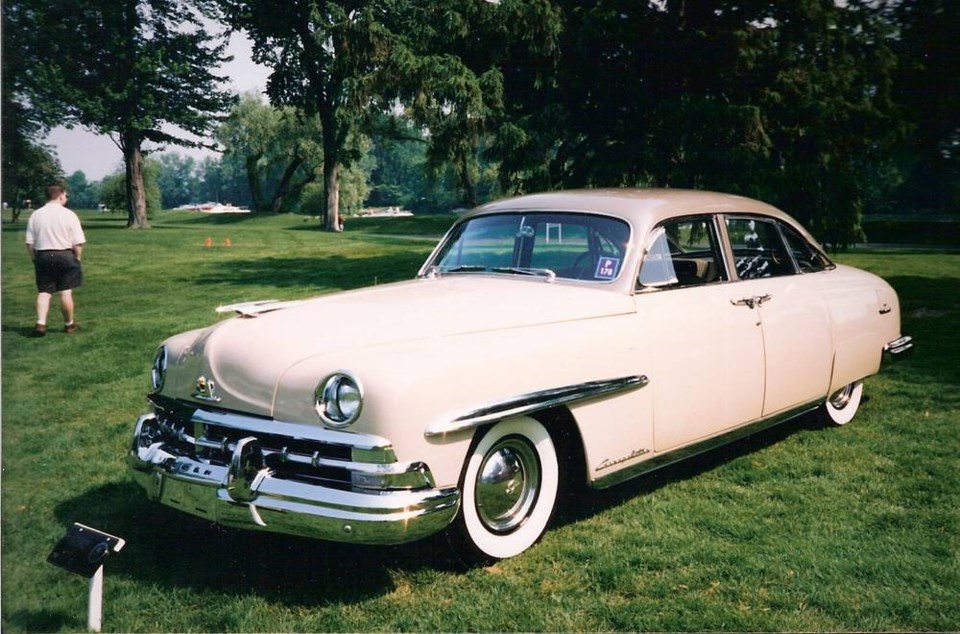Like other car manufacturers immediately after the Second World War, Lincoln offered face-lifted reruns of their 1942 models until they could prepare new ones. When the new 1949 Lincolns did arrive, they were a complete break from the styling of the past.
The new Lincolns introduced in April 1948 were thoroughly modern postwar designs. They looked like larger versions of the equally new Mercury with which they shared some sheet metal. Both had their fenders fully integrated into the body.
By today’s standards, the new Lincolns looked large and bulbous, following the then popularly called “inverted-bathtub” school of design. The rear-hinged rear “suicide doors” were, however, definitely becoming passé.
The standard Lincoln got a two-piece windshield while the more luxurious Cosmopolitan received a modern one-piece. The rear deck was smoothly rounded without any vestiges of the Continental’s distinctive name-inspiring externally mounted spare tire. And large, chrome plated “eyebrows” over the front wheel wells of the 1949-50 Cosmo looked strangely out of place; they would disappear in 1951.
Although hidden headlamps had been planned, they were eliminated late in the design. This left the lights set back in stainless steel “sugar scoop” type tunnels that gave the front end its most distinctive feature: a sad-eyed, new puppy look. It was somehow rather appealing in spite of itself.
Lincolns for 1949 came in two sizes: the standard model and the Cosmopolitan with wheelbases of 3,073 millimetres (121 inches) and 3,175 mm (125 in.). Power came from a new 5.5-litre (337 cu in.) side-valve, 152 horsepower V-8 mated to a three-speed manual transmission with optional overdrive. Ford had not yet developed its own automatic transmission so it made a deal with General Motors to make Hydra-Matic available.
While the V-8 was an improvement over the previous Lincoln V-12, it would be rendered obsolete a few months later by trend-setting short-stroke, overhead valve V-8s from Cadillac and Oldsmobile. This configuration would become the industry standard and Lincoln had to wait a few years for its overhead-valve V-8.
When the new Lincoln got into the hands of car testers, it proved to be a pretty good performer. Tom McCahill of Mechanix Illustrated drove an overdrive-equipped Lincoln to 164 km/h (102 m.p.h.) and claimed it was the fastest American car since the 1937 Cord. The zero to 97 km/h (60 m.p.h.) acceleration times of 15 seconds for the regular Lincoln and 17 for the heavier Cosmopolitan were a little slower than the Cadillac and Oldsmobile 88.
Motor Trend (7/51) tested a duplicate of the Lincoln that won the 1951 Mobilgas Economy Run, which meant it was geared for maximum fuel economy, not performance. Although by that time Lincolns normally came with Hydra-Matic, the economy champ had a three-speed manual transmission with a Borg-Warner overdrive which gave an overall final drive ratio of 2.39:1.
In spite of this ultra-high “plains” gearing, it accelerated to 97 km/h (60 m.p.h.) in 15.6 seconds and averaged a 156 km/h (97 m.p.h.) top speed. In the Mobilgas Run, the Lincoln achieved 25.4 miles per U.S. gallon (9.4 L/100 km) driven by legendary featherfoot Les Viland.
In spite of its size, the Lincoln even enjoyed some racing success. It won two of the 19 National Association for Stock Car Auto Racing (NASCAR) events in 1950, and 16 Lincolns were entered in the first running of the Carrera Panamericana held in 1950.
Better known as the Mexican Road Race, this mad, almost uncontrolled dash was run from one Mexican border to the other. The best 1950 Lincoln finish was ninth; in the 1951 race, a Lincoln finished eighth.
Lincoln also enjoyed political recognition in 1950 when 10 stretched Cosmopolitans became the fleet of the United States Secret Service. A bubble-topped version served presidents Truman, Eisenhower and Kennedy.
After rather slow sales from 1946 to 1948, the all-new ’49s gave Lincoln a boost. With a total of 73,507 regular Lincolns and Cosmopolitans, produced it was Lincoln’s best year to that time. Changes for the three years 1949 to 1951 were confined to grilles and other trim items.
For 1952, it was replaced by an all-new, slimmer, trimmer, more angular Lincoln. Thanks to such advancements as ball-joint front suspension and the new overhead valve V-8 (relegating the side-valve V-8 to truck use), they were much better handlers and performers than the 1949s to 1951s. They became legends by winning the sedan class in the Mexican Road Race from 1952 to ’54 when the event was cancelled.
Although never outstanding cars, the ‘49 to ‘51 Lincolns were big luxurious cruisers. Because of their somewhat bland, bulky styling and mundane mechanicals, they didn’t become strongly sought-after collectibles. But as plush land yachts they were right in step with the times, and could deliver surprisingly good fuel economy.



